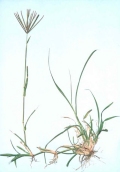
Rhodes grass
NOTE: The information in this Agnote must be read in conjunction with Introduction to selecting and using
pastures in NSW, which covers information on areas of adaptation, sources of variability, species mixtures, and important issues
related to animal health and the conservation of native vegetation.
| Pasture type and use | Summer perennial grass. Used as a pasture plant for both sheep and cattle. Should be grown in conjunction with a legume pasture. Particularly suited to sandy soils and sandy loam. |
|---|---|
| Area of adaptation | Widely adapted, depending on variety. North Coast, North West Slopes and Plains, Central West Slopes and Plains, Hunter and Metropolitan. |
| Min. average annual rainfall | 500 mm (summer-dominant) |
| Advantages |
|
| Disadvantages |
|
| Soil requirements | Adapted to a range of soils, including moderately acid sandy loams through to medium clays. Needs reasonably well drained soils. |
| Varieties | Select varieties on the basis of maturity, ploidy, and local production and persistence data (where available).
* Denotes that this variety is protected by Plant Breeder’s Rights.
|
| Sowing rates: |
|
| Sowing time | September to March |
| Companion species | Annual legumes such as sub clover, medics, serradella, white clover or vetch, depending on climate, soil type and pH. Lucerne can be included on suitable soils. |
| Inoculation | N/A |
| Major nutrient deficiencies | Phosphorus, nitrogen, sulfur. |
| Main insect pests | Few insect pest problems. Seed-harvesting ants can steal surface-sown seed. Army worms have occasionally damaged Rhodes grass pastures in coastal areas. |
| Main diseases | No major disease problems. In less well-drained soils or in wet years, some plant losses from root-rot-related causes have occurred. |
| Management | In the first year, allow Rhodes grass to seed before grazing, or graze only lightly. It can be lightly set stocked or rotationally grazed. To maintain good stock feed value, keep growth relatively short and maintain legume component. |
| Livestock disorders of particular note | This genus can occasionally accumulate dangerously high levels of selenium on some soil types. |
| Additional tips |
|
| Further information | Agfact P2.5.31 Rhodes grass. |
Acknowledgments
Advice on livestock health disorders was provided by Dr Chris Bourke, Principal Research Scientist, NSW Agriculture, Orange. His contribution is gratefully acknowledged.
Photo: Warren McDonald, Former Technical Specialist (Pastures), NSW Agriculture, Tamworth.


